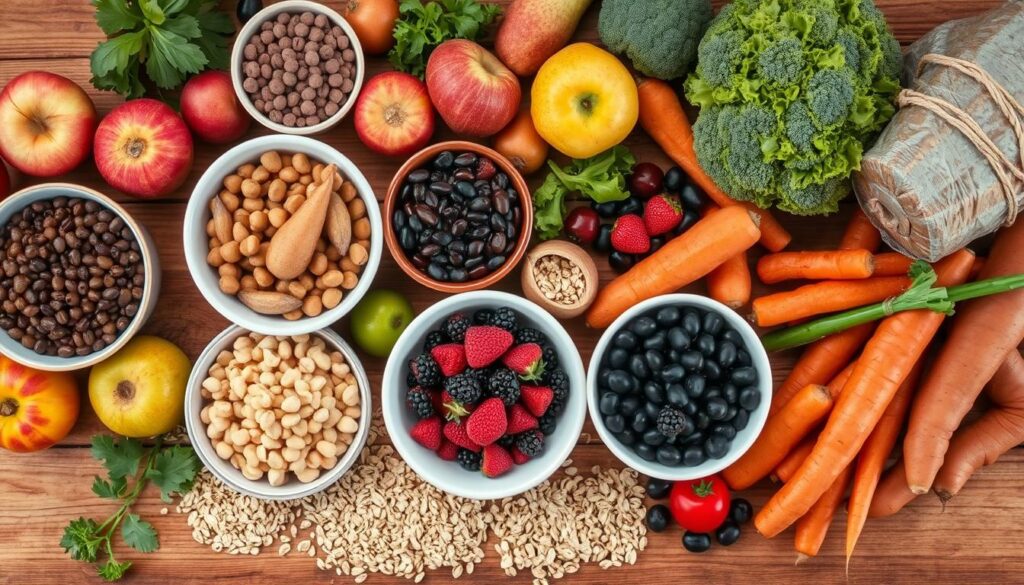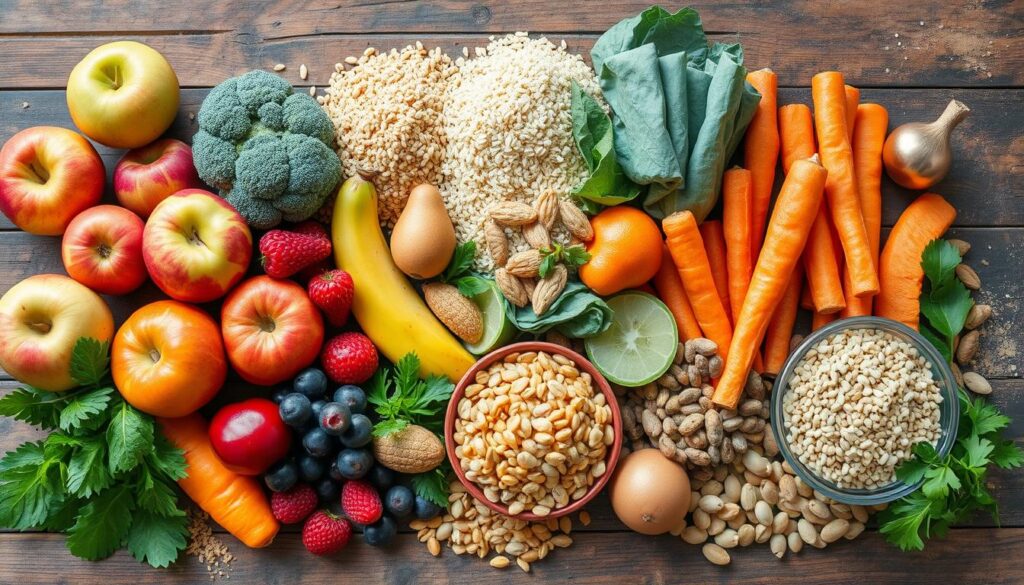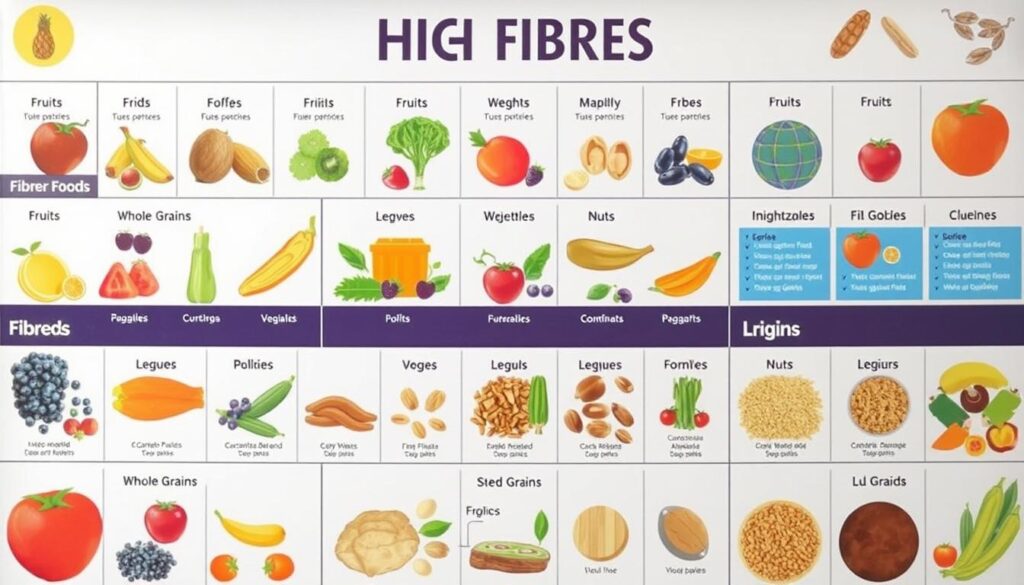Fiber is very important for our health. It helps with digestion, weight management, and preventing diseases. Our high fiber food chart helps you choose the right foods. It shows how to add more fiber to your diet.
Key Takeaways high fiber food chart
- Dietary fiber is a type of carbohydrate that the human body cannot digest, offering numerous health benefits.
- The recommended daily fiber intake is 14 grams per 1,000 calories for adults, yet most Americans fall short of this goal.
- This guide covers a wide range of high-fiber foods, including fruits, vegetables, whole grains, and legumes, with detailed fiber content information.
- Incorporating fiber-rich foods into your meals and snacks can help you meet your daily fiber needs and support overall health.
- Gradual increases in fiber intake are recommended to avoid potential side effects, such as bloating or gas.
Understanding the Importance of Dietary Fiber
Dietary fiber is key to a healthy diet. It’s found in plants and helps with gut health and weight management. Knowing its value helps you choose better foods for your dietary fiber and fiber nutrients needs.
What is Dietary Fiber?
Dietary fiber is parts of plants your body can’t digest. It moves through your body, offering health benefits. Unlike other carbs, it doesn’t turn into glucose, helping keep blood sugar levels healthy.
Health Benefits of Fiber Consumption
- Improved digestion and regularity
- Reduced risk of heart disease and type 2 diabetes
- Promotion of healthy weight management
- Enhanced gut microbiome and overall gut health
- Potential reduction in the risk of certain cancers
Daily Recommended Fiber Intake
The National Academy of Medicine suggests the following daily fiber intake for adults:
| Age/Gender | Fiber Recommendation (grams per day) |
|---|---|
| Women under 50 | 25 grams |
| Women over 50 | 21 grams |
| Men under 50 | 38 grams |
| Men over 50 | 30 grams |
Most people only get half the fiber they need. Eating more fiber, fiber nutrients, and gut health foods can greatly improve your health.
Types of Fiber: Soluble vs. Insoluble
There are two main types of dietary fiber: soluble and insoluble. Knowing the difference helps you choose better for your health.
Soluble fiber dissolves in water, making a gel. It lowers cholesterol and controls blood sugar. You can find it in oats, beans, lentils, apples, and berries.
Insoluble fiber doesn’t dissolve in water. It helps prevent constipation by making stool bulkier. You can find it in whole wheat, veggies, and some nuts and seeds.
Most plant foods have both types of fiber. It’s key to eat a variety to get 25-30 grams of fiber daily. Aim for a mix of both.
| Fiber Type | Description | Food Sources | Health Benefits |
|---|---|---|---|
| Soluble Fiber | Dissolves in water, forming a gel-like consistency | Oats, beans, lentils, apples, berries | Helps reduce cholesterol and regulate blood sugar |
| Insoluble Fiber | Does not dissolve in water, adds bulk to stool | Whole wheat, vegetables, nuts, seeds | Promotes regular bowel movements and prevents constipation |
Knowing the difference between soluble and insoluble fiber helps you make better food choices. It ensures you get the right mix of soluble vs insoluble fiber for your health.
High Fiber Food Chart: Complete Nutritional Guide
Eating foods high in fiber is key for good health. This guide will show you how much fiber is in different foods. It helps you choose the best foods for your health.
Fruits and Their Fiber Content
Fruits are full of fiber. Raspberries have 8g per cup, pears have 6g per medium, and apples have 4g per medium. Adding these fruits to your meals can make your diet more fiber-rich.
Vegetables Rich in Fiber
Vegetables are also great for fiber. Artichokes have 7g per medium, Brussels sprouts have 4g per cup, and broccoli has 2.4g per cup. Eating these veggies can make your meals healthier.
Whole Grains and Cereals
Whole grains and cereals boost your fiber intake. Oats have 4g per cup, quinoa has 5g per cup cooked, and whole wheat pasta has 4g per cup cooked. These foods keep you full and happy.
Legumes and Pulses
Legumes and pulses are fiber powerhouses. Split peas have 8g per 1/2 cup cooked, lentils have 8g per 1/2 cup cooked, and black beans have 7.5g per 1/2 cup cooked. Adding these to your meals is very beneficial.
| Food Item | Serving Size | Fiber Content (grams) |
|---|---|---|
| Raspberries | 1 cup | 8.0 |
| Pears | 1 medium | 6.0 |
| Apples | 1 medium | 4.0 |
| Artichokes | 1 medium | 7.0 |
| Brussels Sprouts | 1 cup | 4.0 |
| Broccoli | 1 cup | 2.4 |
| Oats | 1 cup | 4.0 |
| Quinoa | 1 cup cooked | 5.0 |
| Whole Wheat Pasta | 1 cup cooked | 4.0 |
| Split Peas | 1/2 cup cooked | 8.0 |
| Lentils | 1/2 cup cooked | 8.0 |
| Black Beans | 1/2 cup cooked | 7.5 |
This chart shows the fiber in many foods, like fruits, veggies, grains, and legumes. Eating these foods can make your diet healthier and full of fiber.
Top Fiber-Rich Foods for Maximum Health Benefits
Eating foods high in fiber is key for a healthy gut and body. From raspberries to lentils, many plant-based foods can help. Let’s look at some of the best fiber-rich foods for health.
- Raspberries: These berries have 8 grams of fiber per cup. They’re great for your fiber list.
- Chia Seeds: Two tablespoons of these seeds have 10 grams of fiber. They help your gut health a lot.
- Artichoke Hearts: A cup of cooked artichoke hearts has 14 grams of fiber. They add a lot of fiber to your meals.
- Lentils: This legume has 18 grams of fiber per cup. It’s a big fiber source.
- Chickpeas: Also called garbanzo beans, they have 12 grams of fiber per cup. They’re good for your gut.
- Whole Wheat Spaghetti: Choose whole wheat spaghetti for 7 grams of fiber per cup. It’s a healthier pasta option.
Adding these foods to your diet can make you healthier. They help you meet your fiber needs and keep your gut healthy.
| Food | Fiber Content | Percentage of Daily Value |
|---|---|---|
| Lentils (1 cup, boiled) | 18 grams | 64% |
| Split Peas (1 cup, boiled) | 16 grams | 57% |
| Black Beans (1 cup, canned) | 15 grams | 54% |
| Pinto Beans (1 cup, boiled) | 15 grams | 54% |
| Artichoke Hearts (1 cup, cooked) | 14 grams | 50% |
| Chia Seeds (2 tablespoons) | 10 grams | 36% |
| Raspberries (1 cup) | 8 grams | 29% |
Adding these foods to your meals helps your gut and health. Start slow and increase fiber intake to ease digestion.

Incorporating Fiber into Your Daily Meals
Adding more fiber to your diet is easy. Just make a few changes to your meals. You can enjoy more fiber from breakfast to snacks. This helps your health a lot.
Breakfast Options
Begin your day with fiber-rich breakfasts. Add berries to your cereal or oatmeal for sweetness and fiber. Choose whole-grain breads or overnight oats for a smooth digestive system.
Lunch and Dinner Ideas
At lunch and dinner, eat more whole grains, legumes, and vegetables. Use quinoa or brown rice instead of white carbs. Add lentils, chickpeas, or black beans to your meals. Also, eat lots of leafy greens and cruciferous vegetables.
Healthy Snacking Choices
Choose high-fiber snacks to stay full and energized. Enjoy popcorn, nuts, seeds, or fresh fruits like pears and apples. These snacks are full of fiber and nutrients.
Start slowly to avoid stomach issues. Begin with small fiber increases. By making these changes, you’ll meet your fiber goals and enjoy health benefits.
Tips for Gradually Increasing Fiber Intake
Adding more fiber to your diet is good for your health. But, do it slowly to avoid stomach problems. Here are some tips to help you add fiber slowly and easily:
- Swap out refined grains for whole grains. Use whole wheat or brown rice instead of white bread, pasta, and rice.
- Add an extra serving of vegetables to your meals. Try a side salad, roasted veggies, or a veggie-based soup.
- Mix in some cauliflower rice with your regular rice. Cauliflower rice tastes mild and adds fiber without changing your favorite dishes.
- Snack on high-fiber options like popcorn, nuts, or seeds. These snacks are tasty and full of nutrients.
Drink lots of water when you add more fiber. Water helps your body digest fiber well and prevents stomach issues. These simple steps help you increase fiber slowly and smoothly.
| Fiber-Rich Food | Fiber Content (per cup) |
|---|---|
| Raspberries | 8.0 grams |
| Split Peas | 16.3 grams |
| Artichoke | 10.3 grams |
Slowly add more fiber nutrients and whole food fiber sources to your diet. This way, you get fiber’s health benefits without upsetting your stomach. A slow and steady approach is best for increasing fiber and keeping your diet balanced.

Common Mistakes When Adding Fiber to Your Diet
Adding more fiber to your diet can be good for your health. But, it’s key to do it the right way. Many people make mistakes that can cause bad side effects.
Hydration Requirements
Drinking enough water is very important when you eat more fiber. Fiber pulls water into your body. If you don’t drink enough, you might get constipated, bloated, or feel uncomfortable.
Make sure to drink at least 8 cups (64 ounces) of water every day. This helps your body handle the fiber better.
Portion Control Guidelines
Another mistake is eating too much fiber too fast. This can upset your stomach and cause discomfort. Start with small amounts of high-fiber foods and slowly add more.
Listen to how your body feels. If you notice any bad effects, adjust how much fiber you eat.
By avoiding these mistakes and drinking enough water, you can add more fiber grams per serving and dietary fiber content to your diet. This way, you can enjoy the health benefits that fiber offers.
“Fiber is essential for maintaining a healthy digestive system and promoting overall wellbeing, but it’s important to introduce it gradually and mindfully.”
Special Considerations and Precautions
Adding more fiber to your diet can be good for your health. But, there are some things to watch out for. If you have IBS or diverticulitis, talk to your doctor before adding more fiber. They can help you find the right amount and type for you.
Starting a high-fiber diet slowly is key. Too much fiber at once can cause discomfort. Make sure to drink lots of water to help fiber move through your body.
Fiber supplements can be helpful, but they’re not a full replacement for gut health foods. These foods give you more than just fiber. Always check with a doctor before taking a fiber supplement.


A Life-Changing Experience with This Weight Loss Supplement (Nagano Tonic)
I’ve always struggled with finding a weight loss solution that actually works for me. Like many, I’ve tried numerous diets, exercise routines, and supplements over the years—some worked for a short time, but nothing ever gave me long-term results. That was until I decided to try the weight loss supplement I found : Link to the Supplement.
From the moment I started using it, I noticed a difference. Not only did I feel more energized, but my cravings also became more manageable. The best part? I started seeing results much quicker than I anticipated! Over the course of just a few weeks, I noticed a significant reduction in belly fat and overall weight loss that I hadn’t been able to achieve before.
What makes this supplement stand out from all the others I’ve tried is how it supports me in my daily routine without any jitters or energy crashes. I’m able to stay focused and motivated, which has made it easier to stay on track with my diet and exercise plan.
This product truly exceeded my expectations, and I feel more confident and healthier than ever before. If you’re struggling with your weight loss journey like I was, I highly recommend giving this supplement a try. It’s been a game-changer for me, and I’m sure it can work wonders for you too!
Contant Them on email .. tonicnagano50@gmail.com
I’ve tried so many weight loss products over the years, but nothing worked like this supplement! Since I started using it, I’ve noticed a big difference in my energy levels and appetite control. In just a few weeks, I’ve lost weight and feel so much better. It’s been easy to stick with, and the results speak for themselves. Highly recommend this to anyone looking to make a real change!
I was skeptical at first, but this supplement has truly made a difference in my weight loss journey. I’ve lost weight without feeling deprived or sluggish. My cravings are under control, and I feel more confident in my body. It’s easy to incorporate into my daily routine, and the results speak for themselves. I’m so glad I gave it a try!
Thanks David, i do use the link to make my purchase. you can get too here http://surl.li/iasppy
wasn’t sure what to expect, but this weight loss supplement has really impressed me! After just a few weeks of use, I’ve already dropped a few pounds and feel more motivated to stay active. It’s helped curb my cravings and boosted my energy throughout the day. I’m excited to keep going and see even better results. Definitely worth trying!
Reach them on tonicnagano50@gmail.com
I’ve tried so many weight loss products, but this one has been by far the most effective. In just a few weeks, I’ve noticed a visible difference in my body and energy levels. It’s helped me stay on track without the constant hunger pangs and cravings. I’m really happy with my progress and can’t wait to see where I’ll be in another month!
This Nagano Tonic has been amazing! In just a few weeks, I’ve lost weight, feel more energized, and my cravings are under control. Highly recommend it!
Thats the link to purchase http://surl.li/iasppy